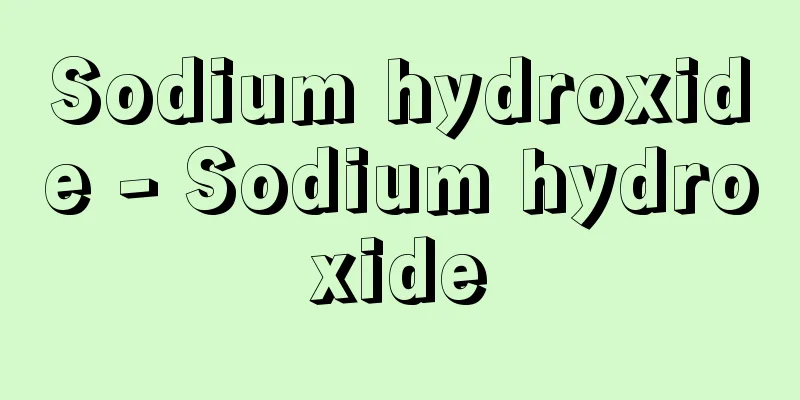Sodium hydroxide - Sodium hydroxide

|
A hydroxide of sodium. It is also known as caustic soda. Caustic means "attacks the skin." The caustic soda industry is said to have begun in 1884 at a factory in Glasgow, where soda mother liquor was causticized with milk of lime. Nowadays, all caustic soda is produced by electrolyzing salt water. Commercially available products include those that are melted and poured into drums to solidify, and those that are molded into flake, rod, or hemispherical tablets. Quality is regulated by JIS (Japan Industrial Standards) and the Food Sanitation Act. [Torii Yasuo] Manufacturing methodIndustrial manufacturing methods include the caustic method and the electrolytic method. [1] Caustic process The aqueous solution of crude sodium bicarbonate produced by the ammonia soda process is made to absorb carbon dioxide (gaseous carbon dioxide) to produce sodium carbonate stock solution, which is then mixed with milk of lime to produce Na 2 CO 3 + Ca(OH) 2 - → 2NaOH + CaCO 3 [2] Electrolysis There are three methods for electrolyzing an aqueous sodium chloride solution: the mercury method, the diaphragm method, and the ion exchange membrane method. (1) Mercury method: This method uses a metal electrode (such as graphite) as the anode and mercury as the cathode, in which sodium discharged at the negative electrode dissolves in the mercury to form amalgam. This sodium amalgam is then introduced into a mercury dissolving tank where it reacts with water to obtain sodium hydroxide. This method is superior in terms of product quality, but has problems with high electricity costs and the use of large amounts of expensive, hazardous mercury. In Japan, there is a rapid shift to other methods. (2) Diaphragm method: Electrolysis is performed using a metal electrode as the anode and iron as the cathode, with an asbestos diaphragm between the two electrodes. Chlorine is produced at the anode, and sodium hydroxide along with hydrogen is produced at the cathode. The diaphragm prevents the products at the two electrodes from mixing. This method is excellent in terms of high power efficiency, but it is inferior to other methods in terms of purity, as it has a high rate of contamination with sodium chloride and sodium chlorate. (3) Ion exchange membrane method: A method of electrolysis in which the negative and positive electrode chambers are separated using a cation exchange membrane. The reaction at both electrodes is exactly the same as in the diaphragm method, but this method is superior in terms of purity, with a low rate of sodium chloride contamination, and future developments are expected. [Torii Yasuo] natureIt is deliquescent, and when left in the air it absorbs moisture and dissolves, and at the same time absorbs carbon dioxide gas to become sodium carbonate. It dissolves easily in water, generating a large amount of heat in the process. Its aqueous solution is strongly alkaline. It dissolves well in ethanol (ethyl alcohol) and glycerin, but not in ether or acetone. It does not decompose into oxides and water even when heated strongly, but it melts easily and attacks gold, platinum, silicic acid, etc., so it is used to melt solid substances that are difficult to react with, such as rocks. It reacts with carbon monoxide to become sodium formate, and saponifies fats and oils to produce soap and glycerin. It also decomposes organic matter such as proteins and cellulose. [Torii Yasuo] ApplicationsIt has a wide range of uses across the entire chemical industry, including the production of rayon, staple fiber, cellophane, paper, pulp, soap, dyes, fragrances, pesticides, medicines, aluminum metal and various sodium salts, and the refining of petroleum and oils and fats. It is also used as an analytical reagent, desiccant, and carbon dioxide absorbent. [Torii Yasuo] NoteSince it is a highly toxic substance (allowable concentration is 2 milligrams per cubic meter), if the solution touches the skin or gets into the eyes, it is necessary to wash thoroughly with water and then with boric acid solution, etc. If it is ingested by mistake, drinking a large amount of lemon water, milk, or egg whites is also effective. [Torii Yasuo] [Reference item] | | | [Supplementary material] |Source: Shogakukan Encyclopedia Nipponica About Encyclopedia Nipponica Information | Legend |
|
ナトリウムの水酸化物。カ性ソーダcaustic sodaの別名がある。カ性とは「皮膚を侵す」の意。1884年グラスゴーの工場でソーダ母液を石灰乳でカ性化したのがカ性ソーダ工業の始めであるといわれている。現在ではすべて食塩水の電解によって製造されている。製品として市販されているものには、融解後ドラム缶に流し込んで固化したものと、片状・棒状あるいは半球形錠剤に成形したものなどがある。品質はJIS(ジス)(日本工業規格)および食品衛生法によって規定されている。 [鳥居泰男] 製法工業的な製造法にはカ性化法と電解法がある。 〔1〕カ性化法 アンモニアソーダ法によって生じた粗重曹の水溶液に炭酸ガス(気体二酸化炭素)を吸収させて炭酸ソーダ原液とし、これに石灰乳を加えて 〔2〕電解法 塩化ナトリウム水溶液を電気分解する方法で、水銀法、隔膜法、イオン交換膜法の三つの方法が行われている。 (1)水銀法 陽極に金属電極(黒鉛など)、陰極に水銀を用いる方法で、負極で放電したナトリウムが水銀に溶けてアマルガムとなる。このナトリウムアマルガムを解汞(かいこう)槽に導いて水と反応させ、水酸化ナトリウムを得ている。製品の品位の点で優れているが電力費が高く、高価で有害な水銀を多量に使用する点が問題である。日本では他の方法への転換が急速に進んでいる。 (2)隔膜法 陽極に金属電極、陰極に鉄を用い、両極間にアスベスト製の隔膜を入れて電解する。陽極で塩素、陰極で水素とともに水酸化ナトリウムが生成する。隔膜によって両極の生成物の混合が防止されている。この方法は電力効率が高い点で優れているが、塩化ナトリウムや塩素酸ナトリウムの混入率が高く、純度の点で他の方法に劣る。 (3)イオン交換膜法 陽イオン交換膜を用いて陰陽両極室を分離して電解を行う方法。両電極における反応は隔膜法とまったく同じであるが、塩化ナトリウムの混入率が低いなど純度の点では優れており、今後の進展が期待される。 [鳥居泰男] 性質潮解性で、空気中に放置すると湿気を吸って溶けるとともに、炭酸ガスを吸収して炭酸ナトリウムとなる。水に溶けやすく、その際大量の熱を発生する。水溶液は強アルカリ性を呈する。エタノール(エチルアルコール)、グリセリンにもよく溶けるが、エーテル、アセトンには溶けない。強熱しても酸化物と水に分解しないが、簡単に融解し、金、白金、ケイ酸などを侵すので、岩石など反応しにくい固体物質を融解するのに用いられる。一酸化炭素と反応してギ酸ナトリウムとなり、油脂をけん化してせっけんとグリセリンを生ずる。またタンパク質、セルロースなどの有機物を分解する。 [鳥居泰男] 用途化学工業全領域にわたって広い用途をもっている。レーヨン、ステープルファイバー、セロファン、紙、パルプなどの製造、せっけん、染料、香料、農薬、医薬などの製造、金属アルミニウムや各種ナトリウム塩の製造、石油、油脂の精製などがおもなものである。そのほか分析試薬、乾燥剤、二酸化炭素吸収剤に用いられる。 [鳥居泰男] 注意劇薬(許容濃度1立方メートル当り2ミリグラム)であるから、水溶液が皮膚に触れたり、目に入ったりした場合には、水でよく洗ったのち、ホウ酸水などで洗う必要がある。誤飲した場合には、レモン水を大量に飲むほか、牛乳、卵白を飲むのも有効である。 [鳥居泰男] [参照項目] | | | [補完資料] |出典 小学館 日本大百科全書(ニッポニカ)日本大百科全書(ニッポニカ)について 情報 | 凡例 |
>>: Copper hydroxide - Suisankado
Recommend
Modern masterpieces - Kindai Shuka
This is a book on waka poetry by Fujiwara Teika. ...
Hessen, B. (English spelling) HessenB
...Works such as "The History of Science fro...
Nitti, Francesco Saverio
Born: July 19, 1868, Melfi [Died] February 20, 195...
Galabia - Galabia
…It is a corrupted Egyptian dialect of the Arabic...
Arowana - Arowana (English spelling)
A large freshwater fish belonging to the family O...
Empress Jitō
An emperor of the Hakuho period. The 41st emperor...
Simmons, D.
…Ngata Apirana Ngata’s (1874-1950) Maori Songs (1...
Single work - Tansaku
Cultivating only one type of crop in a field. In ...
Alstroemeria (English spelling)
A plant of the genus Lily of the Amaryllidaceae fa...
TDK Corp. - TDK
A major electronic parts manufacturer. Formerly th...
Smock (English spelling)
The English word for a top. Its origin is smoc, wh...
Cone shell - Cone shell (English spelling)
A general term for snail shells of the Conidae fam...
Solidus gold coin
A gold coin used from the late Roman Empire to the...
Ibaramo - Ibaramo
A submerged annual plant of the family Diptera (il...
Jumping seed
...Three seeds form a cluster, and each seed has ...









